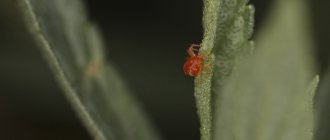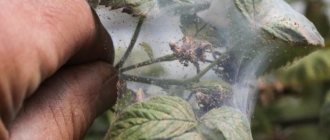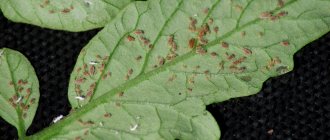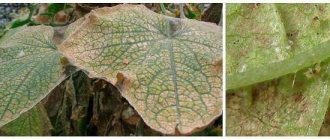Spider mites (Tetranychidae), contrary to popular belief, are not an insect, but an arachnid. This is a large family, comprising 95 genera and more than 1270 species. Many are dangerous pests of ornamental and agricultural crops. Representatives of the family infect various plants by sucking cell sap from leaves, flowers, buds, and young stems. The spider mite on tomatoes belongs to the species Tetranychus urticae and is called Common.
Why are spider mites dangerous on tomatoes?
Every gardener knows that tomatoes are a very capricious crop. The main danger for tomatoes is that the insect feeds on the sap of the plant, gradually sucking all the vitality out of it. Plant death occurs suddenly.
Parasites live in colonies and remain in the soil, contaminating it with their presence. Further seedlings that are planted on the ground with mites are already doomed in advance.
Typically, ticks immediately attack greenhouses, because there are favorable conditions for their existence. The result of such attacks is the complete destruction of the crop.
Causes of the pest
Basically, spider mites appear in places where comfortable living conditions are created for them. Greenhouses and greenhouses are an ideal place both for living and breeding, and for overwintering a colony. For complete comfort they need a temperature of +22 to +25 degrees Celsius and low humidity up to 60%.
The pest can enter the soil along with the transplantation of infected seedlings, in which case the soil is affected for several seasons. Most often this happens if ready-made seedlings were purchased. It may also be that seeds or seedlings are planted in already contaminated soil. After all, spider mites hide all winter at a depth of 3 meters.
Another common reason for the appearance of this pest in your garden may be the presence of nearby wildflowers that are infected with the parasite.
Description
Systematic position: class arachnids, order acariform mites, family spider mites (Tetranychidae).
Polyphage, damages vegetable crops of the pumpkin, nightshade, legume, etc. families, ornamental and flower crops.
The female is 0.45 mm long, with an oval body bearing 6 transverse rows of setae on the upper side; oviparous females are greenish with dark spots on the sides; Diapausing females are reddish-red without spots. The male is 0.35 mm long, with an elongated body, noticeably narrowed towards the posterior end. The egg is light, translucent. Larvae have three pairs of legs, nymphs and adults have four. It differs from other species of spider mites in the shape and size of the copulatory organ of the males.
Individual development includes egg, larval, protonymph, deutonymph and adult stages; the mobile stages are separated by three molts. Fertilized females produce females and males, unfertilized females produce males.
Diapausing females overwinter in cracks in the internal structures of greenhouses, on weeds, in the soil substrate and other shelters. They emerge from diapause when seedlings are planted in the ground and the temperature and humidity rise at the same time. The females settle on the underside of the leaves, where after 3-4 days of feeding they change their color to green and lay eggs. The laying period at moderate temperatures lasts for 25-30 days, the female produces on average about 80-100 eggs. The duration of generation development is determined mainly by temperature and is 8-10 days under favorable conditions (25-27 °C).
The life cycle of spider mites in the autumn-winter-spring period (until mid-April) is determined by the living conditions of larvae and nymphs on plants with appropriate limits of photoperiod, temperature and food quality. Under conditions when the photoperiod does not exceed 14-16 hours and the temperature is 19 °C, diapausing females develop; at higher values of at least one of these parameters, oviparous females develop. Since the temperature in greenhouses can vary greatly in the winter-spring period, some females remain on the leaves, laying eggs, while others go into diapause, where they spend 10-30 days or more at temperatures of 22-25 °C. They can be prevented from going into diapause either by additional lighting (over 16 hours) or by maintaining a temperature above 21 °C. In greenhouses, the common spider mite can produce over 20 generations.
When feeding, leaf mesophyll cells are mechanically damaged. With heavy colonization, necrosis appears, eventually covering the entire surface of the leaf; the leaves become entangled in cobwebs. Plant respiration and photosynthesis are inhibited, and productivity sharply decreases.
In greenhouse plants, in addition to the common spider mite, vegetable plants can be damaged by Atlantic (Tetranychus atlanticus McGregor), Turkestan (T. turkestani Ug. et Nik.) and red (T. cinnabarinus Boisd.) spider mites. Populations of the first two species develop in the same way as the common spider mite. Populations of the latter species, as a rule, do not have diapause.
Signs of tick infestation
Spider mites on tomatoes do not have wings or antennae. He has 4 pairs of legs. Females are slightly larger than males and reach a size of 0.5 mm. Males have an elongated body and are yellow-green in color, their size reaches 0.4 mm. The eggs of these insects are yellowish and translucent, so it is almost impossible to see them.
Ticks are practically omnivorous and, in addition to tomatoes, readily destroy melons, eggplants, cucumbers and other plant crops. They live mainly in greenhouses and greenhouses. This is due to the ideal conditions that form inside. Arachnids overwinter three meters deep in the ground, under greenhouse boards or under plant waste in open ground.
In the advanced phase, a sign of damage will be the presence of thin and dense cobwebs on the leaves.
You definitely have spider mites in your garden if you have the following symptoms:
- Whitish dots appear on the main veins of the leaves, which subsequently turn yellow.
- The same dots may appear on plant stems.
- The lower leaves curl at the edges and then dry out.
- Small grayish lumps, similar to specks of dust, accumulate on the reverse side of the leaf.
- The appearance of a thin, dense cobweb throughout the plant.
- Lack of flowers.
- The plant dries out despite regular watering or spraying.
Note! After you see the web, you must immediately take measures to combat spider mites in the greenhouse, dig up the plant and burn it in a remote place. And also cultivate the soil nearby.
Preventive measures
As you know, prevention is the best remedy against any disease, both human and plant. Of course, carrying out preventive work will take you some time, but it will most likely help you grow a good harvest of tomatoes, cucumbers, eggplants, and other vegetables or berries.
Prevention measures:
- Remove all debris from the site, paying special attention to removing fallen leaves, stems and other parts of the plant;
- Disinfect the soil if your area was infested with spider mites last summer. The soil can be spilled with boiling water, an acaricide solution, or sprinkled with a bleach solution, and then dug up;
- If you are growing tomatoes and other vegetables in a greenhouse, then be sure to carry out work to disinfect the soil, supporting structures and other surfaces of the greenhouse;
- It is better to begin work on disinfecting the greenhouse in the fall. After disinfection or replacement of soil, wash all accessible surfaces with an acaricidal solution, and then use sulfur bombs to disinfect the room; (Photo)
- Do not open the greenhouse for at least five days after using smoke bombs;
- Before planting tomato seedlings, carefully inspect and, if necessary, disinfect each plant. Often spider mite eggs, and even adults, end up in a bed of seedlings;
- When planting tomatoes, follow the rules of crop rotation. Do not plant tomatoes several times in the same place, make sure that crops prone to spider mite damage are not adjacent to each other;
- Do not thicken your beds; it is important that the tomatoes are well ventilated and ventilated;
- Water tomatoes in open ground in a timely manner. Create in the greenhouse the most unfavorable microclimate for spider mites: humidity above 85% at temperatures up to 250C;
- Inspect the plants regularly and remove debris near the roots. Provide sufficient amounts of phosphorus fertilizers and limit the use of chemicals with large amounts of nitrogen;
- Some gardeners place sticky tape around the bushes, which traps and kills harmful insects.
Pest control methods
Before starting to treat plants, it is worth choosing the optimal and effective way to combat spider mites. To do this, it is necessary to assess and take into account the degree of contamination of the site.
When taking measures to combat spider mites on tomatoes, it is worth paying attention to their maturity and the possible source of infection.
Below we will introduce you to the most effective means of combating this pest. It is a representative of arachnids, so standard remedies for garden parasites will not work.
Chemicals
Acaricides or insectoacaricides should be used against an almost invisible enemy. During the period when the plant begins to bear fruit, you should not treat it with chemicals. Disinfection with strong poisons should be carried out at least 2-3 weeks before collection.
For chemical treatment, you can choose one of the following drugs:
- Neoron;
- Anti-mite;
- Aktellik;
- Fufanon;
- Sunmite;
- Aktofit;
- Spark – BIO;
- Flumite;
- Borneo.
The method of application is identical for everyone. First, a solution is prepared, which is then used to spray the tomatoes themselves. It is imperative to disinfect the soil near the planting. The walls of greenhouses and greenhouses should be treated at the same time; experienced gardeners prepare for the season and spray them in advance.
It is better to apply a loading dose of drugs immediately in order to prevent further proliferation of pests.
Worth remembering! Spider mites develop immunity to certain chemicals.
Favorable conditions
Many species of spider mites, including Tetranychus urticae, are well adapted to mid-latitude conditions.
In the Leningrad region, the pest can produce 8-10 generations per year, in the southern part of Russia - 12 generations. The best conditions for the colony are created in greenhouses.
| Factor | Optimal conditions |
| Temperature | The highest rate of tick development is observed at +29…+31°C. The pest loses its ability to reproduce only at temperatures below +12°C. For comparison, at +15°C the egg matures in 15 days, at +30°C this period is reduced to 3 days. |
| Humidity | The parasite prefers dry air (35-55%). In rainy summers, when air humidity is above 60%, colony growth slows down significantly. |
| Weakened plants | A lack of light, nutrition and especially watering reduces the resistance of tomatoes to pest attacks. Sluggish, drooping leaves can be pierced even by weak representatives of the species. |
| Tight fit | In dense plantings, plants not only suffer from a lack of resources, but also come into contact with the tops, which facilitates the spread of the mite. |
| Weeds | Many types of wild grasses can serve as food sources for spider mites. In an overgrown area, arthropods quickly move from one plant to another. |
| Early age of tomatoes | The most vulnerable are young tomatoes, the leaves of which are tender enough that the pest can easily bite through them. |
Biological methods
Unlike toxic chemicals, biological control of spider mites on tomatoes in a greenhouse is safe and non-toxic. They should be used when the situation is not critical, as they act more slowly and less aggressively. But the safety of the future product and the effectiveness of its impact are excellent.
There is a good Russian proverb “they knock out a wedge with a wedge”; it applies to one of the methods of getting rid of parasites. It is necessary to release predatory mites into the area. Such insects will destroy their relatives and free the garden from harmful parasites. Another advantage is that predators feed not only on adults, but also on eggs, which means that next season the problem can be forgotten.
In addition to the army of carnivorous mites, you can declare a full-fledged biological war on pests. To do this, you need to purchase special products that contain special bacteria that infect spider mites. The following drugs are particularly effective:
- Akarin;
- Phytofarm;
- Krafi;
- Mites.
Biological agents can be used at any stage, during flowering and fruiting too.
Where does it winter
The change in color of females at the end of summer or at the beginning of autumn is associated with the cessation of feeding and preparation for wintering. Only fertilized females survive until spring.
Such females are resistant to cold temperatures down to -28°C and in some regions overwinter in the upper layers of the soil. The maximum survival rate is among “greenhouse” mites.
Remains of tops and weeds on the site, cracks in the bark of trees, and a layer of fallen leaves also become a haven for spider mites.
Without autumn treatment of shelters and soil, and cleaning the area, it is impossible to remove the pest.
In spring, the spider mite wakes up when the temperature rises to +12°C and begins laying eggs.
The first generation of arthropods is represented by individuals of both sexes.
Folk remedies
Folk remedies will be an excellent alternative to various poisons in the fight against mites on tomatoes. Such remedies for mites on tomatoes have been tested for centuries and many generations, so there is no doubt about their effectiveness.
Laundry soap
Ordinary laundry soap should be dissolved in hot water. To make the process easier, you can grate it. Observe the proportions: for 100 g of soap, 1 liter of water. After this, pour water into a spray bottle and gently spray the leaves of the infected plants.
After some time, it is worth spraying the same plants with clean water so that they do not suffocate. Repeat the treatment after a few days to consolidate the effect.
Do not water the soil around the tomatoes, only the leaves and stems as needed.
Garlic
This method of controlling spider mites is effective in the early stages of damage.
There are several recipes for the infusion:
- 30 g of chopped garlic is poured into 10 liters of hot water and left for 24 hours. After straining, it is necessary to spray the leaves of infected plants.
- Chop 500 g of garlic and add 3 liters of water at room temperature. Infuse for 5 days in a dark place, after which be sure to strain the infusion. Use 50 ml of infusion per 10 liters of water and spray the plants.
- For emergency disinfection, mix 200 g of chopped garlic in 10 liters of water. Plants can be treated with this solution immediately.
For prevention purposes, you can plant garlic next to tomatoes; spider mites do not get along next to them.
Onion peel
Onions are extremely unpleasant for the parasite. In order to make an effective decoction, you will need 200 g of onion peel per 10 liters of warm water. The mixture is infused for 12 hours in a warm place, then filtered, and everything is ready for spraying.
Makhorka
Shag can be used in 2 ways: to fumigate plants or to irrigate. To prepare the infusion you will need 200 g of shag, 20 liters of water and 50 g of soap. You need to infuse 10 liters of water in shag for 24 hours, then filter, boil the broth and add soap to it. After this, dilute the infusion with another 10 liters of warm water.
Next, after thorough mixing, you can carry out the spraying procedure. Fumigation is carried out in a standard way.
Henbane
Black henbane is widely known for its poisonous properties. The high level of toxicity of this plant will help in the fight against parasites. It will not be possible to dry henbane, because it quickly loses its properties while in a jar or bag.
To prepare the decoction, you should collect 3 kg of fresh plant, preferably during flowering. Then you need to boil the herb in 7 liters of water in an enamel pan for about 2 hours. Strain the broth and it is ready for spraying.
If you still use dried henbane, then 10 liters of water will require 1 kg of plants. The solution should be infused for 12 hours, and then add a little laundry soap for better effectiveness.
Alcohol
There are many opinions about how to properly treat plants with alcohol. Some gardeners say that it is necessary to dilute this product before spraying so as not to injure the plant. However, this is a serious misconception.
Tomatoes should be treated with 96% alcohol in low humidity conditions. Only in this case will it quickly evaporate from the surface of the leaves and not cause harm. If you dilute the concentrate, the substance will slowly evaporate and penetrate into the pores of plants along with moisture, thereby corroding their tissue.
Treatment should be carried out for 4 weeks in a row, once every 7 days.
Agrotechnical measures
If the pest does reach your garden, you need to take a number of measures to repel the parasite from your tomatoes:
- Supplementary irrigation. As you know, mites do not like excess moisture, so additional watering will immediately rid you of pests. But it is important not to overdo it with this method, otherwise the crop will simply drown.
- If you notice an infected bush, it should be dug up and burned immediately. You need to do the same with fallen dry leaves. This method is good if the affected area is single.
- In autumn or spring, the soil should be dug up and fumigated with sulfur. After these activities, it is worth leaving the greenhouse closed for 5 days, and after a specified time, ventilate for 2 days.
- Chemical treatment of all parts of the greenhouse and soil after harvest will save you. The soil must be treated with chemicals before the onset of winter. The walls of the greenhouse also need to be sprayed with compounds, dried and reinstalled.
Note! Try to chemically treat the area before planting tomatoes or after harvesting.
Pepper diseases in a greenhouse
At the end of July, cold nights usually begin, which peppers really don’t like and drop ovaries and even fruits. If the weather is rainy, then rot appears on the fruits at the point where the stalk is attached, and the fruits fall off.
At the same time, in such weather, a white coating often appears on the stems - stem rot. If urgent measures are not taken, rot will encircle the stem and it will wither. As soon as you notice that plaque has appeared, immediately wipe the area with a dry cloth, then cover it with a mixture of chalk and potassium permanganate or wash the infected area with a cloth soaked in a solution of potassium permanganate and dust well with ash.
When fruit rot appears on peppers, tomatoes, or eggplants, water the plants with a solution of calcium nitrate (2 tablespoons per bucket). Add 1 tablespoon of chlorine-free potassium to the solution. In addition, spray the plants with Zircon or a solution of Fitosporin spore mass.
The same measures should be taken if blossom end rot occurs on the fruit: first a spot appears on the top of the fruit, then it begins to rot. This usually occurs in dry and hot weather with insufficient watering. From the tops of ripening fruits, the outflow of moisture, potassium and calcium begins to the point of plant growth. The fetal tissue becomes dehydrated and then destroyed. For this reason, also in July, further growth should be stopped, for which they pinch off the tops not only of tomatoes, but also of peppers and eggplants.
Preventing the appearance of spider mites on tomatoes
The best way to combat spider mites is to prevent their occurrence. After all, if you do not allow the parasite into your garden, then there will be no problems with its removal and loss of harvest. Here are a few rules that can prevent the appearance of this insect:
- Plant seedlings at a distance of at least 25 cm from each other. Too frequent planting promotes the development of mites and increases the likelihood of complete destruction of the crop.
- Avoid weeds and weed the area frequently.
- After harvesting, be sure to remove the remaining tops and dig up the soil, otherwise you will create an ideal place for overwintering ticks with your own hands.
- Plant crops next to tomatoes where spider mites cannot survive: garlic, dill, celery, calendula, basil.
- Try not to use nitrogen supplements, since it is this element that creates favorable conditions in the soil for the proliferation of spider mites.
- The insect does not tolerate phosphorus, so the soil in which root nutrition is organized with this element will not allow the appearance of parasites.
The best preventive measure would be good, comprehensive garden care. A weakened plant that lacks something will certainly be attacked by mites.
How it spreads
In the spring, ticks feed on weeds, then master planted garden seedlings, green garden or ornamental crops.
Active spread begins in late spring or early summer.
The parasite can enter the treated area from the outside, as it can be carried by:
- wind;
- insects;
- birds;
- animals;
- person – on hands, clothes, shoes.
Once in a greenhouse or an open garden bed, the spider mite spreads through tools that have not been disinfected, plant debris, and in dense plantings it independently moves from leaf to leaf.
Mistakes of novice gardeners
Inexperienced gardeners make mistakes that will later become critical for the entire harvest. Here are examples of the most serious violations:
- Reuse of prepared chemical solutions.
- The desire to cure a plant at a critical stage. After you notice a cobweb, the bush must be immediately removed and the soil under it disinfected.
- The use of cheap chemicals from previous generations that harm humans, the soil and the plants themselves.
- Excessive moisture when signs of damage to tomatoes are detected.
Before using chemical agents, carefully read the composition and conditions of use so as not to harvest a poisonous crop later.
Effective folk and chemical remedies for spider mites
Spider mites are a very unpleasant parasite that is difficult to remove and difficult to detect. If you grow tomatoes, be sure to check the backs of the plants' leaves. Maintain conditions of acceptable humidity, which will be fatal to the insect. Try to heat-treat the soil for seedlings, this will prevent the appearance of uninvited guests. Remember, it’s easier to keep any parasite out of the garden than to remove it!











